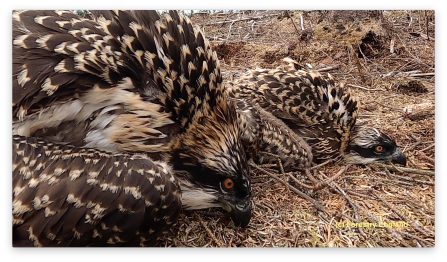Ringing osprey chicks is no mean feat as it involves a 30 foot climb by one of Forestry England’s qualified climbers who retrieve the chicks from the nest and lower them carefully in the bag to waiting Consultant Ornithologist, Martin Davison. Each chick is then weighed and measured. Although this is not an exact science it helps in determining whether the birds are male or female because females are generally larger and heavier.
Coloured (blue for 2020) and numbered rings are fitted to the young ospreys’ legs. These rings will help identify the ospreys in future and allow their progress to be monitored. Through the ringing process it has been possible to determine that 2020 is the best year so far for returning ospreys, with three individuals who were born in Kielder making their way back this year.
Finally the chicks are named - this year’s chicks have been named after Northumberland places beginning with D. In total there are ten new arrivals this year - 4 males and six females from five nests. The 2020 roll call is:
Nest 1A: 215/Dinmont, 216/Derwent, 217/Dunmoor
Nest 2: 212/Dunstanburgh
Nest 4: 210/Darden, 211/Denwick
Nest 6: 218/Druridge, 219/Dilston
Last but not least, news of Nest 7 from Wayne Penrose, Forestry England Ecologist and climber. Wayne said “It has been particularly exciting to assist with the ringing at Nest 7 – a new nest on a pole which was only erected earlier this year and the first breeding attempt for the newly formed couple.”

